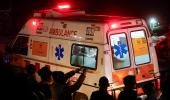Suddenly they heard a thud. By the time they could understand what had happened panic stuck, recalled Sukhram who returned home in Khirabeda, a nondescript village on the outskirts of Ranchi, in the early hours of Saturday.

Sukhram, all of 22, reached his village at 1 am to a rousing welcome after staying trapped in the Silkyara tunnel for 17 days.
Relishing 'murga bhaat' or chicken rice, his favourite meal, Sukhram told PTI, "Childhood games like 'raja-rani' and 'chor-sipahi' kept us alive and kicking after initial days of gloom, despair and hopelessness."
"We were engaged in gantry and concrete work inside the tunnel when we heard a thud, and the realisation of what had happened gave us chills down the spine. We stood shocked and shaken. It froze us and many of us thought it was the end," he said.
Sukhram said that they sent the signal of being trapped inside by cutting the pipe, which was discharging muddy water outside, with the gas cutter.
"As soon as the contact with the outside was established, hopes were kindled and soon we started getting dry ration like 'muri', cashew and raisins through a compressed pipe," he said.
During the initial days, 'muri' or puffed rice and dry fruits that were sent inside got dirty, Sukhram said, "But, we used a 'chalni' meant for separating gravels from sand to clean them."
Whatever was delivered, it was divided among the 41 people who were stuck inside, he said.
"For water, we depended initially on water dripping from rocks. At times we played games, at times we talked about our families and thought of our future. All games that we played during childhood came to our rescue," he recalled.
Sukhram said that after the first 10 days of gruelling anxiety, items such as khichdi, biryani, and roti and sabzi started coming in through a larger pipe, besides bananas, apples and oranges.
"For relieving ourselves, we had no other option but to do it inside the tunnel. It was done at the farthest end and then covered with mud," he said.
"Prayers had become a routine for us and finally God heard us. We cannot describe our happiness on coming out alive and what gives much satisfaction is the people outside were happier than us. We thank the people of the nation from the bottom of our hearts and extend special thanks to PM Narendra Modi, and CM Hemant Soren, who has assured us to provide employment opportunities here," an emotional Sukhram said.
His paralysed mother Parvati, who was inconsolable after she found out about the disaster, was too happy to express her feelings.
A total of 13 people from the village had gone to Uttarkashi on November 1 in search of greener pastures and little did they know what fate had in store for them.
Luckily, only three of them were inside the tunnel when the disaster struck. The two others were Rajendra and Anil, both in their early 20s.
Fifteen of the 41 workers, who were struck inside the tunnel, hailed from the state.
Vijay Horo, a worker from Karra in Khunti, said the initial three days were harrowing but they were hopeful.
Horo, a undergraduate Arts student, said it was like a new birth for all of them.
The rescue operation began on November 12 after a portion of the under-construction tunnel on the Char Dham route collapsed following a landslide, cutting off the exit for the workers inside.











 © 2025
© 2025